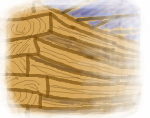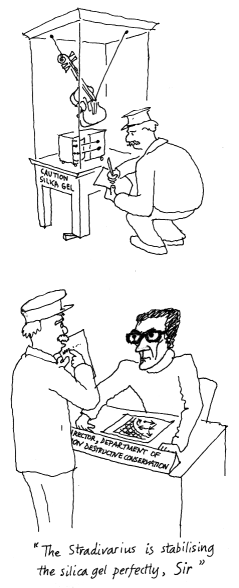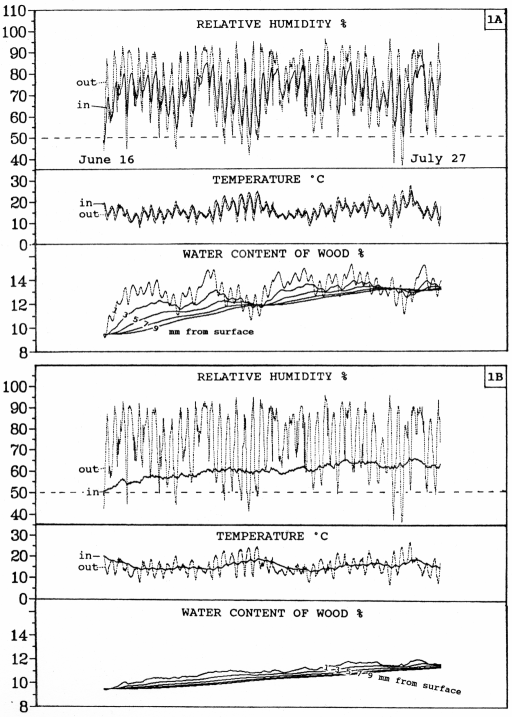
 |
Low energy climate control
|
by Tim Padfield and Poul Jensen
This is an extended version of an article published in the conference proceedings: International Council of Museums, Committee for Conservation, 9th triennial meeting, Dresden 1990 pp.596-601.
A computer model of a museum store is used to explore the effects of various methods of air conditioning. A room that is filled with an abundance of hygroscopic material can be held at a constant relative humidity by blowing in a stream of air, about one twentieth of the room volume per hour, which has a water content adjusted to be in equilibrium with the desired water content in the hygroscopic materials. This method works even if the temperature is uncontrolled, because of the buffer effect. The room also needs air recirculation at about one change per hour to ensure temperature uniformity and to allow the removal by filtration of internally generated pollutants.
Orthodox air conditioning consumes a lot of energy. The regulatory system takes air from the room, mixes in a portion of outside air, cools the mixture to the correct dew point and then heats it up again before injecting it into the room. A store room heavily loaded with hygroscopic materials such as wood, paper, and textiles buffers its own climate so well that the continual heating and cooling of the air is unnecessarily fussy and wastes energy.
 The concept of relative humidity (RH) buffering by hygroscopic materials in
showcases and in packaging for transport is a well understood and abundantly
described conservation principle. The same principle applies in storage rooms.
The amount of buffer needed is large, if one regards deliberately added buffer
as the sole regulatory force. In practice the stored objects and their
containers buffer themselves. The distinction between the valuable object and
the humble buffer has no meaning in physics. The two materials share the process
of moisture exchange which holds them in equilibrium with the surrounding air.
Each object surrounded by a mass of its hygroscopic companions fares just as
well as one object protected by silica gel.
The concept of relative humidity (RH) buffering by hygroscopic materials in
showcases and in packaging for transport is a well understood and abundantly
described conservation principle. The same principle applies in storage rooms.
The amount of buffer needed is large, if one regards deliberately added buffer
as the sole regulatory force. In practice the stored objects and their
containers buffer themselves. The distinction between the valuable object and
the humble buffer has no meaning in physics. The two materials share the process
of moisture exchange which holds them in equilibrium with the surrounding air.
Each object surrounded by a mass of its hygroscopic companions fares just as
well as one object protected by silica gel.
Experimenting with a whole room is an expensive enterprise so we present here
the climate patterns obtained with a computer model made to explore the possible
ways of air conditioning a store room.
The program calculates the temperature and relative humidity of a room filled with variable amounts of wood, which is our model of a hygroscopic material. The outside climate data are the hourly values of temperature and relative humidity given in the "Test reference year" for Copenhagen (1). The inside climate is calculated every twelve minutes. Heat and water transfers between room air and outside air are calculated using the standard formulæ and constants found in air conditioning handbooks (2). The program segment which calculates water vapour exchange with wood uses data from the ASTM standard (3)(see Fig. 2a). This unpublished calculation is described in an appendix. The model is "robust" in the sense that errors in the rate of equilibration of the wood have little effect on the course of the climate. The absorption isotherm of wood is the dominant influence and it is known with sufficient accuracy.
The model room is 15 metres by 30 by 4.5 m high. It has two exterior walls of k value (thermal transmission) 0.2 W/m2.°C. Ventilation is adjustable from 0.05 to 0.5 air changes per hour. The air is recirculated at one air change per hour. Air speed over the wood surface is 0.1 m/s. A lightly buffered room is represented by 200 square metres of wood, ten millimetres thick, varnished on one side. A heavily buffered room is represented by 5000 square metres of wood. This is not an unusually large amount of hygroscopic material for a store room of this size with a mixed collection. The target RH is set at 50% only to simplify reading the graphs.
On the following pages five control strategies, published (4,5) and unpublished, are interpreted in turn. The computer generated climates are presented in a series of graphs. These show relative humidity and temperature, inside and out, for the period June 16 to July 27 in the "test reference year". Where relevant, the fresh air exchange rate is displayed. For some graphs the moisture content in the wood at various depths is also displayed. There are two sets of graphs for each control method: A shows the climate in a lightly buffered room (200 m2 wood), 'B' shows the climate in a heavily buffered room (5000 m2 wood). The graphs labelled 'C' provide data needed to understand the control method, or its effect.

Without climate control the lightly buffered room 'A' rapidly comes to equilibrium with the outside climate. The buffering effect of the wood surface is rapidly exhausted and diffusion from the deeper layers is too slow to give any help with stabilising the daily fluctuation in RH. The heavily buffered room in 'B' shows the expected slow drift towards the average outside relative humidity. The daily RH cycle is totally buffered, partly by the large area of wood surface but also because of the buffering of the daily temperature cycle by the heat capacity of the wood. The wood moisture content steadily rises towards equilibrium with the outside RH. The winter average relative humidity in Denmark is about eighty five percent so this method of totally passive control will clearly not do. The graph does, however, give some insight into the power of the buffering effect in a well filled room with reasonable ventilation.

This work is licensed under a Creative Commons Attribution-Noncommercial-No Derivative Works 3.0 License.